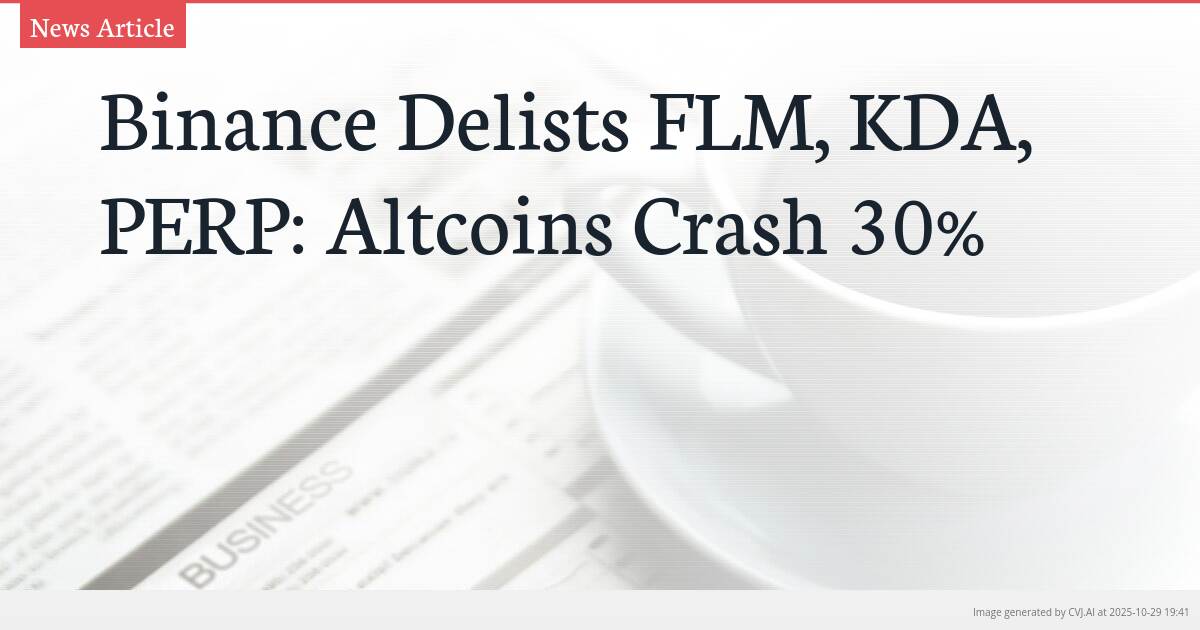This summary text is fully AI-generated and may therefore contain errors or be incomplete.
Introduction
The cryptocurrency market witnessed dramatic volatility as Binance, the world’s largest digital asset exchange, announced the delisting of three altcoins—Flamingo (FLM), Kadena (KDA), and Perpetual Protocol (PERP)—effective November 12. The decision, stemming from the exchange’s periodic review process to maintain listing standards, triggered immediate price reactions across the affected tokens, with KDA collapsing 30% to an all-time low while FLM surprisingly surged 25%, defying typical delisting patterns.
Key Points
- Kadena (KDA) plunged 30% to an all-time low of $0.04 following the delisting news, while PERP dropped 15%.
- Flamingo (FLM) unexpectedly surged 25% to a one-month high of $0.03, contrary to typical delisting reactions.
- Binance will stop supporting deposits after November 13, 2025, and withdrawals after January 12, 2026 for the delisted tokens.
The Delisting Decision and Immediate Market Impact
Binance’s announcement on October 29 revealed that Flamingo (FLM), Kadena (KDA), and Perpetual Protocol (PERP) would be removed from trading services after failing to meet the exchange’s ongoing listing criteria. The company clarified that all trading operations involving these cryptocurrencies will cease on November 12, with deposits no longer credited after November 13, 2025, and withdrawals unsupported after January 12, 2026. This systematic delisting process represents Binance’s commitment to maintaining platform standards, but typically carries severe consequences for affected assets through reduced liquidity, diminished visibility, and reputational damage.
The market reaction was immediate and severe for most of the targeted cryptocurrencies. Kadena (KDA) suffered the most dramatic decline, with its valuation collapsing by nearly 30% on a daily scale to reach an all-time low of $0.04 according to CoinGecko data. Perpetual Protocol (PERP) followed a similar downward trajectory, posting a 15% loss as traders exited positions ahead of the trading suspension. The rapid devaluation demonstrates what market participants commonly refer to as the ‘Binance Effect’—where exchange decisions can trigger massive price movements in the highly sensitive cryptocurrency market.
FLM's Surprising Defiance of Market Expectations
While KDA and PERP followed the expected pattern of decline following delisting news, Flamingo (FLM) presented a remarkable anomaly. Contrary to typical delisting reactions, FLM’s price exploded to a one-month high of $0.03 before slightly retreating to $0.02, representing a 25% surge over 24 hours. This unexpected movement defied market logic, as such price trajectories typically occur when Binance embraces new cryptocurrencies through listings rather than removing existing ones from its platform.
The FLM surge presents a puzzling case study in cryptocurrency market dynamics. While delistings generally trigger sell-offs as investors seek to exit positions before liquidity dries up, FLM’s counterintuitive rally suggests either coordinated buying, short covering, or potential misinterpretation of the announcement by some market participants. The anomaly highlights the unpredictable nature of cryptocurrency markets, where sentiment and technical factors can sometimes override fundamental news developments.
The Binance Effect: Historical Precedents and Market Power
Binance’s influence on cryptocurrency valuations extends well beyond delisting events. The exchange’s decisions to introduce new trading products have historically generated equally dramatic positive price movements. Approximately one month prior to the current delistings, Binance launched the FLUID/USDT perpetual contract with up to 75x leverage, triggering a 55% valuation surge for FLUID shortly after the disclosure. This pattern was even more pronounced with the STBL/USDT perpetual contract introduction, where the involved cryptocurrency’s price exploded by nearly 500% following the announcement.
These historical cases demonstrate the substantial market power wielded by major exchanges like Binance. The introduction of perpetual contracts—derivative products allowing speculation on asset prices with borrowed money without ownership—typically generates significant trading volume and price appreciation. The stark contrast between the positive ‘Binance Effect’ from new product launches and the negative impact of delistings underscores the exchange’s pivotal role in determining cryptocurrency liquidity and valuation trajectories.
The current delisting event reinforces Binance’s position as a market maker whose decisions can create or destroy value overnight. For cryptocurrency projects, maintaining exchange listings has become a critical component of survival in an increasingly competitive landscape. As Binance continues its periodic reviews, market participants will closely watch for further delisting announcements that could trigger similar volatility across the cryptocurrency ecosystem.
📎 Read the original article on cryptopotato.com

